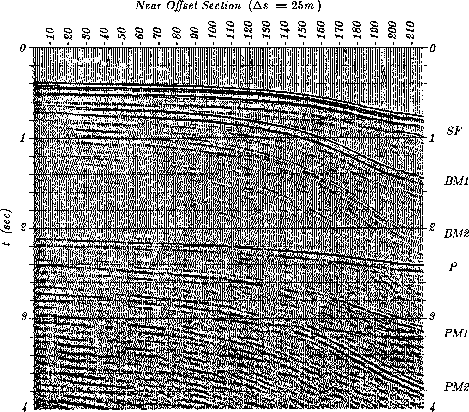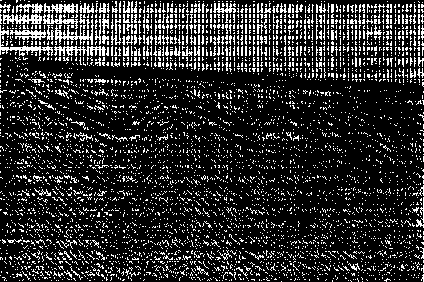 |
Figure 6 Raypaths are displayed for (a) a water-bottom multiple, (b) a pegleg multiple family, and (c) a short-path multiple.
Multiple reflections fall into one of three basic categories--see Figure 6.
 |
Water-bottom multiples are those multiples whose raypaths lie entirely within the water layer (Figure 6a). Since the sea floor usually has a higher reflectivity than deeper geological horizons, water-bottom multiples often have strong amplitudes. In deep water these multiples can be very clear and distinct. A textbook-quality example is shown in Figure 1.
Pegleg multiple reflections are variously defined by different authors. Here pegleg multiples (Figure 6b) are defined to be those multiples that undergo one reflection in the sedimentary sequence and other reflections in the near surface.
To facilitate interpretation of seismic data, let us review
the timing and amplitude relations
of vertical-incidence multiple reflections in layered media.
Take the sea-floor two-way travel time to be t1 with
reflection coefficient c1.
Then the ![]() multiple reflection
comes at time
multiple reflection
comes at time ![]() with reflection
strength c1n.
Presume also a deeper primary reflection at travel-time
depth t2 with reflection coefficient c2.
The sea-floor peglegs arrive at times
with reflection
strength c1n.
Presume also a deeper primary reflection at travel-time
depth t2 with reflection coefficient c2.
The sea-floor peglegs arrive at times ![]() .Note that peglegs come in families.
For example, the time
.Note that peglegs come in families.
For example, the time ![]() could arise from three
paths,
could arise from three
paths, ![]() ,
, ![]() ,or
,or ![]() .So the
.So the ![]() order pegleg multiple echo is really a
summation of
order pegleg multiple echo is really a
summation of ![]() rays, and
thus its strength is proportional to
rays, and
thus its strength is proportional to ![]() .The sea-floor reverberation is c1n, which is not the same
function of n as the
function that describes reverberation on sediments,
.The sea-floor reverberation is c1n, which is not the same
function of n as the
function that describes reverberation on sediments,
![]() .Ignoring the sea-floor reverberation itself
you can just think of
.Ignoring the sea-floor reverberation itself
you can just think of ![]() as a shot waveform.
as a shot waveform.
Every multiple must have a ``turn-around'' where an upcoming wave becomes a downgoing wave. Almost all readily recognized multiples are surface multiples, that is, they have their turn-arounds at the earth's surface. Figure 7 shows some clear examples.
 |
In land data the turn-around can be at the base of the soil layer, which is almost the same as being at the earth's surface.
A raypath that is representative of yet another class of multiples, called short-path or intrabed multiples, is shown in Figure 6c. Their turn-around is not at or near the earth's surface. These multiples are rarely evident in field data, although Figure 8 shows a clear case in which they are.
 |
When they are identified, it is often because the seismic data is being interpreted using some accompanying well logs. The reason that short-path multiples are so rarely observed compared to peglegs is that the reflection coefficients within the sedimentary sequence are so much lower than on the free surface. The weakness of individual short-path multiples may be compensated for, however, by the very large numbers in which they can occur. Any time a seismic section becomes incomprehensible, we can hypothesize that the data has become overwhelmed by short-path multiples.